Installing frameless cabinets is a rewarding project that can enhance the functionality and aesthetic appeal of any space. Frameless cabinets, also known as European-style cabinets, offer sleek, modern design and maximize storage capacity by eliminating the face frame found in traditional cabinetry.
However, the installation process requires careful planning and precision to ensure a seamless result. From preparing the space and assembling the cabinets to securing them in place and adding finishing touches, each step plays a crucial role in achieving a professional-quality installation.
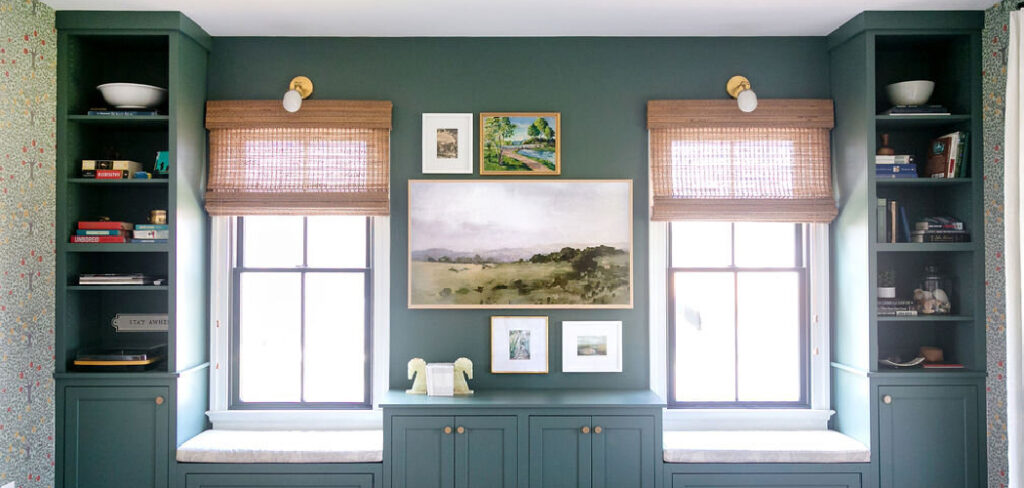
In this comprehensive guide, we’ll explore the step-by-step process of how to install frameless cabinets, offering valuable insights and expert tips to help you tackle this project with confidence and create a stylish and functional living environment.
Importance of Frameless Cabinets
Frameless cabinets play a significant role in modern kitchen design and organization, offering a blend of aesthetic appeal and functional advantages. Unlike traditional cabinetry, frameless designs provide an unobstructed interior space, facilitating easier access and storage of larger items.
This efficiency in space utilization makes frameless cabinets a preferred choice for those seeking to maximize kitchen functionality. Additionally, the sleek and minimalistic appearance of frameless cabinets aligns perfectly with contemporary and minimalist design trends, offering a clean and updated look to any kitchen.
The absence of a face frame also allows for tighter spacing between doors and drawers, which contributes to a more streamlined and cohesive aesthetic. By selecting frameless cabinets, homeowners can enjoy a modern kitchen that is not only visually appealing but also enhanced in terms of storage capacity and organization.
Benefits of Frameless Cabinet Installation
Choosing to install frameless cabinets comes with a myriad of advantages that extend beyond their modern aesthetic. One of the primary benefits is the increase in usable storage space. Without the intrusion of face frames, every inch of the cabinet box is available for storage, allowing for more efficient organization and the ability to store larger items with ease.
Additionally, frameless cabinet construction provides for tighter door and drawer margins, which results in a more uniform and pleasing appearance. This can be particularly advantageous in smaller kitchens where maximizing space and maintaining a clutter-free look is essential.
Furthermore, the installation of frameless cabinets can enhance the overall value of a home. Their contemporary design and efficient function appeal to potential homebuyers, making them a smart investment for those considering future resale.
Lastly, frameless cabinets offer greater accessibility. The absence of a face frame allows for wider drawers and easier access to cabinet contents, which is a significant advantage for individuals with mobility issues or anyone looking to create a more user-friendly kitchen environment.
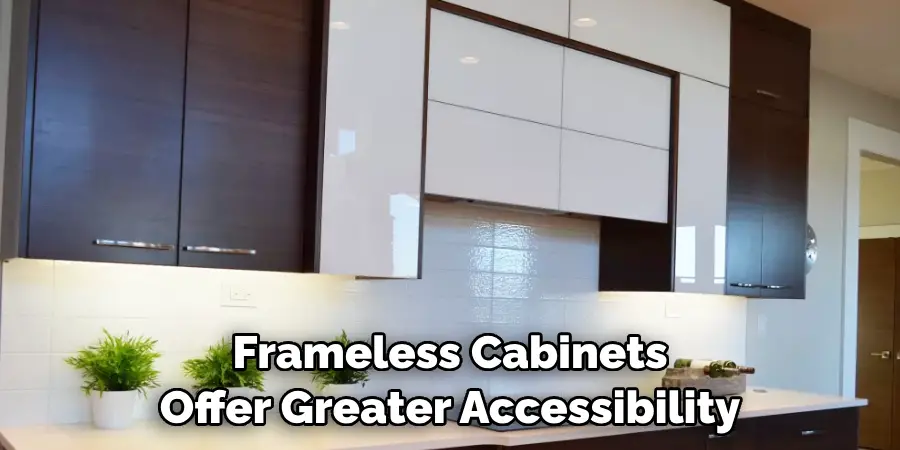
Planning Your Installation
Before commencing the installation of your frameless cabinets, a meticulous plan is essential to ensure success and minimize any potential hiccups during the process. This planning stage involves several key steps:
- Measurement and Space Assessment: Start by measuring the space where you intend to install the cabinets. Accurate dimensions of the area, including height, width, and depth, are crucial for selecting the right cabinet sizes and understanding how they will fit into your kitchen layout. Also, consider any obstacles like windows, electrical outlets, or plumbing fixtures that may affect the installation.
- Design Layout: Utilizing your measurements, create a detailed layout of your kitchen, factoring in the placement of appliances and how you intend to use the space. This is the time to decide on the arrangement of base cabinets, wall cabinets, and tall cabinets to optimize functionality and flow in the kitchen.
- Selection of Cabinets: Based on your layout and the dimensions of your kitchen, select the frameless cabinets that best fit your needs. Consider factors such as the type of finish, color, and hardware that will complement your kitchen’s design aesthetic.
- Tools and Materials: Compile a list of tools and materials you will need for the installation. Common tools for installing frameless cabinets include a level, drill, measuring tape, stud finder, and screws. It’s also wise to have a pencil and paper on hand for marking drill holes and aligning cabinets accurately.
- Scheduling: Determine a realistic timeline for your project. Consider how much time you can dedicate each day to the installation and any help you might need from friends or professionals, especially for tasks that require more than two hands.
- Preparation of the Installation Area: Prepare the area where the cabinets will be installed. This may involve removing old cabinetry, repairing and painting walls, and ensuring the floor is level. A clean, prepared space is critical for a smooth installation process.
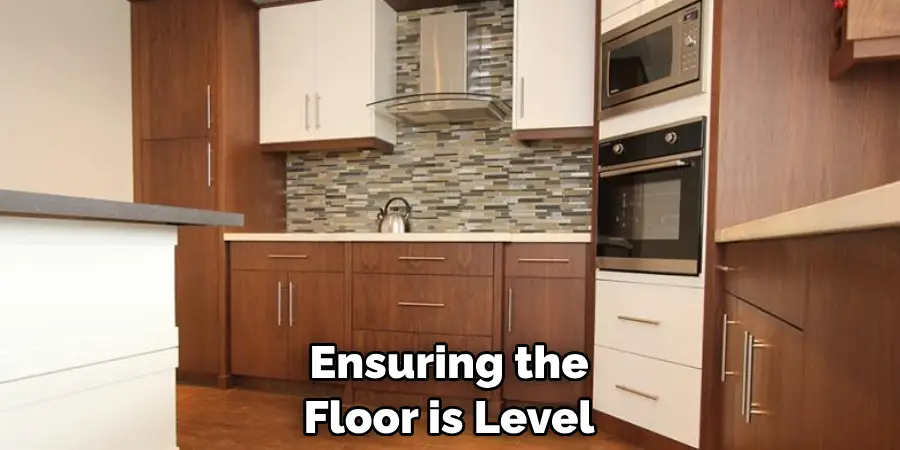
Assessing Kitchen Layout and Design
Having a well-thought-out kitchen layout and design is paramount before proceeding to install your frameless cabinets. It directly influences the efficiency, functionality, and overall aesthetic appeal of your kitchen.
When assessing your kitchen’s layout, consider the “work triangle” principle, which focuses on the placement of the sink, refrigerator, and stove. The goal is to minimize the distance between these three key areas to enhance cooking efficiency and reduce unnecessary movement.
Equally important is the consideration of your kitchen’s specific design style. Frameless cabinets, with their sleek and modern look, tend to complement contemporary, minimalist, and transitional kitchen designs exceptionally well.
Evaluate the color palette, finishes, and textures that will best match your frameless cabinets to ensure a cohesive and visually pleasing kitchen environment.
Going for a harmonious design will not only elevate the aesthetics of your kitchen but also its overall value.
When planning your kitchen layout, don’t forget to account for ample counter space and storage solutions, ensuring that the cabinets you choose will meet your storage needs without cluttering the kitchen. Incorporating features such as pull-out drawers, spice racks, and under-cabinet lighting can further enhance the functionality and ambiance of your kitchen.
Determining Cabinet Placement and Configuration
After assessing your kitchen’s layout and design, the next critical step is determining the most efficient placement and configuration of your frameless cabinets. This process involves a strategic approach to aligning your cabinets with the overall flow of the kitchen, ensuring ease of access and optimal functionality.
Key considerations for placement include the cabinet’s proximity to major appliances and workstations. It’s essential to maintain a logical sequence that follows your kitchen’s workflow — typically from refrigerator to sink to stove. This helps in minimizing unnecessary steps while preparing meals, improving the overall efficiency of the kitchen.
When it comes to configuration, focus on the balance between base cabinets, wall-mounted cabinets, and tall pantry cabinets to maximize storage. Keep in mind the frequency of use for items that will be stored in each cabinet, placing everyday items at more accessible levels.
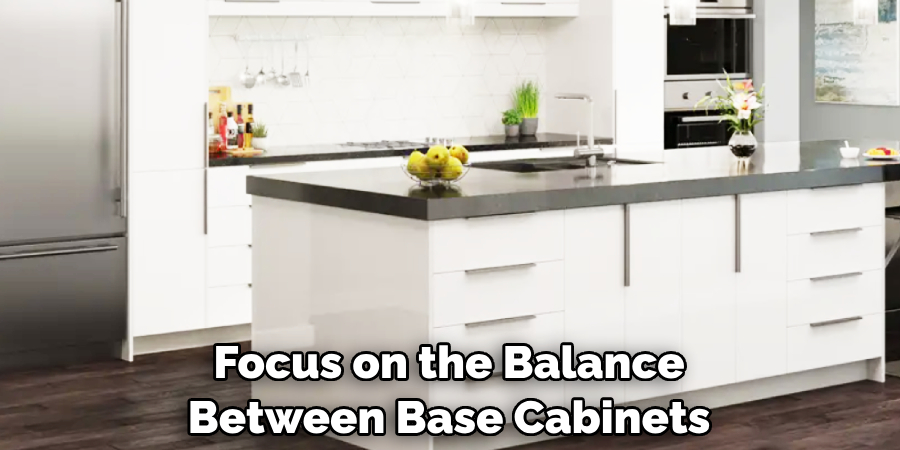
For instance, placing dishes and glassware near the dishwasher eases unloading, while pots and pans are best kept near the stove.
Gathering Necessary Tools and Materials
Before commencing the installation of your frameless cabinets, it is critical to gather all necessary tools and materials to ensure a smooth and efficient process. This preparation step cannot be overstated in importance, as having the right tools on hand is vital to avoid delays and ensure the highest quality installation.
Essential Tools:
- Measuring Tape: For precise measurements of space and cabinet dimensions.
- Level: To ensure all cabinets are installed straight and aligned.
- Drill: For securing cabinets to walls and assembling parts.
- Screwdriver: Handy for manual adjustments and fittings.
- Stud Finder: Crucial for locating studs in the wall to anchor cabinets securely.
- Screws and Anchors: Specifically designed for cabinet installation, to hold the cabinets firmly in place.
- Pencil and Notepad: For marking drill points and taking notes on measurements and adjustments.
- Clamps: To hold cabinets together tightly while securing them in place.
Additional Materials:
- Shims: For leveling cabinets in case of uneven floors or walls.
- Caulk and Caulk Gun: For sealing gaps and ensuring a finished look around the cabinets.
- Finishing Nails: For securing trim and mouldings.
- Protective Gear: Safety goggles and gloves to protect from dust and injury during the installation process.
Gathering these tools and materials before beginning your project will streamline the installation process, preventing unnecessary pauses to procure missing items.
Remember, a well-prepared workspace is the foundation of a successful cabinet installation. By ensuring you have everything you need from the start, you can focus on the precise and careful installation of your frameless cabinets, bringing your kitchen one step closer to completion.
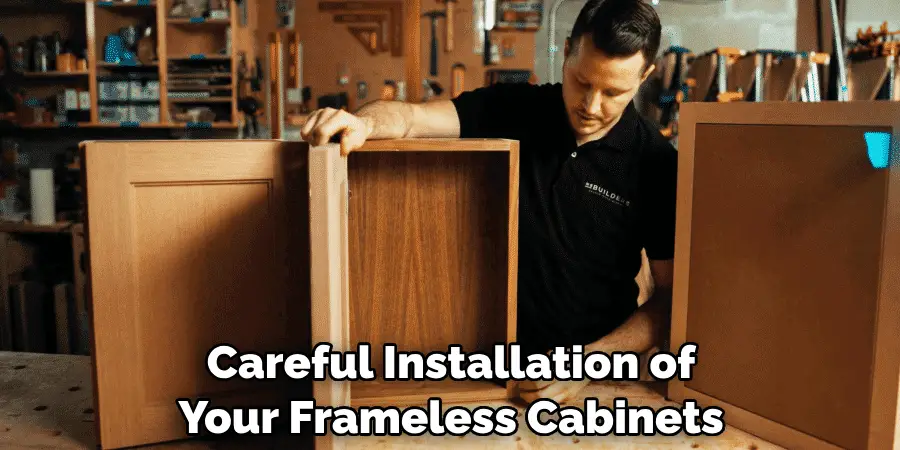
Preparing the Workspace
Before initiating the installation of your frameless cabinets, preparing your workspace is essential to ensure safety and efficiency. Start by clearing the kitchen area completely, removing existing cabinetry, appliances, and ensuring a clean, clutter-free floor space.
This not only facilitates easier movement around the kitchen during installation but also minimizes the risk of accidents or damage to your new cabinets and appliances.
Next, protect your kitchen’s flooring by laying down durable drop cloths or sheets of plywood, especially in areas where heavy lifting or movement of tools and materials will occur. This precaution helps prevent scratches, dents, or other damage to your floors during the installation process.
It’s also wise to create a temporary storage area for the cabinets and tools you’ll be using. This could be in an adjacent room or a specially designated space within the kitchen area that does not obstruct the workflow. Organizing your tools and materials in this space allows for easy access and keeps them from becoming hazards.
Additionally, ensure that your workspace has adequate lighting and ventilation. Good visibility is crucial for precision work such as measuring, cutting, and aligning, while proper ventilation is important for your health and comfort, especially if you’re working with volatile substances like paints, stains, or adhesives.
Ensuring Proper Ventilation and Lighting
Proper ventilation and lighting are critical components in the kitchen, especially during the installation of frameless cabinets. Ensuring adequate airflow and visibility not only promotes a safer work environment but also significantly impacts the functionality and comfort of your kitchen once the project is completed.
Ventilation Considerations:
- Exhaust Systems: Installing a high-quality exhaust system or range hood can efficiently remove smoke, steam, and odors produced during cooking, keeping the air in your kitchen fresh.
- Window Placement: If possible, plan for windows near cooking areas to allow for natural ventilation. Windows can be opened to remove excess heat and introduce fresh air, enhancing the overall air quality in the kitchen.
- Ventilation Grills: Incorporating ventilation grills into the design of your base cabinets or toe-kicks can help improve airflow throughout the kitchen.
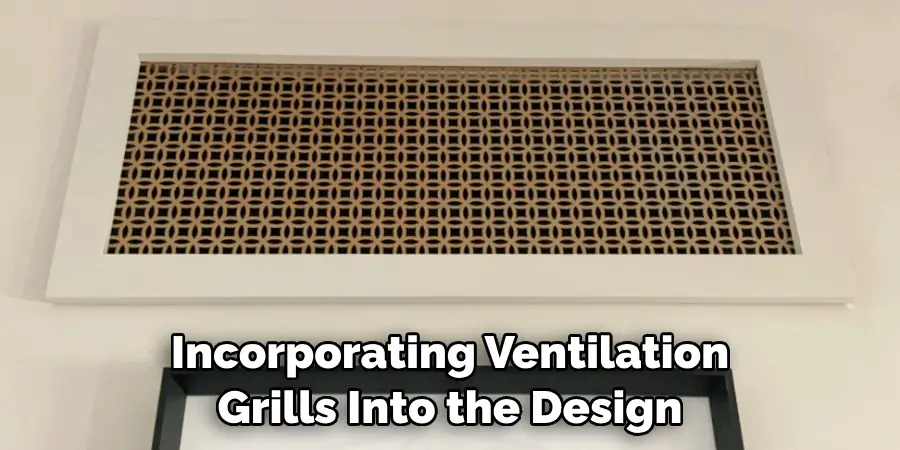
Lighting Considerations:
- Task Lighting: Install under-cabinet lighting to illuminate countertops, providing adequate lighting for food preparation and cooking tasks. LED strip lights are a popular, energy-efficient option.
- Ambient Lighting: Consider the overall lighting design of your kitchen to ensure it is well-lit and inviting. Overhead lighting, combined with natural light from windows, can create a warm and welcoming space.
- Accent Lighting: Use accent lighting to highlight specific areas of your kitchen, such as glass-front cabinets or artwork. This type of lighting adds depth and dimension to the space.
By prioritizing ventilation and lighting in your kitchen, you create a healthier and more enjoyable environment for both the installation process and the many years of kitchen use that follow.
Proper ventilation ensures that airborne particles and odors are efficiently removed, while adequate lighting enhances safety, functionality, and the aesthetic appeal of your space.
10 Methods How to Install Frameless Cabinets
1. Prepare the Workspace:
Start by clearing the area where the cabinets will be installed. Remove any existing cabinetry, appliances, or obstacles that may interfere with the installation process. Ensure that the walls and floors are clean and free of debris to provide a smooth surface for mounting the cabinets.
2. Gather Necessary Tools and Materials:
Before beginning the installation, gather all the tools and materials you’ll need. This may include a drill, screws, a level, shims, a stud finder, a tape measure, a pencil, and safety equipment such as gloves and goggles. Having everything on hand will streamline the installation process.
3. Mark Cabinet Placement:
Using a tape measure and pencil, mark the layout of the cabinets on the wall. Start by locating the highest point on the floor and measuring up from there to determine the height of the base cabinets. Use a level to ensure that the cabinet lines are straight and evenly spaced.
4. Locate Wall Studs:
Use a stud finder to locate the wall studs behind the drywall. Mark the stud locations on the wall with a pencil. Frameless cabinets rely on sturdy wall support, so it’s important to anchor them securely to the studs for stability.

5. Install Hanging Rails:
Attach hanging rails to the wall at the top of the cabinet layout using screws and a drill. The hanging rails provide additional support for the cabinets and help distribute the weight evenly across the wall. Make sure the rails are level and securely anchored to the studs.
6. Hang Upper Cabinets:
With the hanging rails in place, it’s time to hang the upper cabinets. Lift each cabinet into position and align it with the layout marks on the wall. Use shims to level the cabinets and adjust their positioning as needed. Once the cabinet is level and flush with the adjacent cabinets, secure it to the hanging rails with screws.
7. Install Base Cabinets:
Next, install the base cabinets following the same process. Position each cabinet in its designated location and use shims to level it. Once the cabinet is level, anchor it to the wall studs with screws through the back panel. Ensure that the cabinets are aligned with each other and that there are no gaps between them.
8. Secure Cabinets Together:
After all the cabinets are installed, secure them together using cabinet connectors or screws. This will help stabilize the cabinets and create a seamless appearance. Follow the manufacturer’s instructions for installing the connectors and ensure that they are evenly spaced along the cabinet seams.
9. Add Cabinet Hardware:
Once the cabinets are securely in place, install the cabinet hardware such as drawer pulls and door handles. Measure and mark the placement of the hardware before drilling holes and attaching the hardware securely. This finishing touch will complete the look of your frameless cabinets and make them functional for everyday use.

10. Adjust Doors and Drawers:
Finally, adjust the doors and drawers to ensure smooth operation and proper alignment. Use the adjustment screws on the hinges and drawer slides to fine-tune the fit of the doors and drawers. Make any necessary adjustments to ensure that the doors open and close smoothly and that the drawers glide easily in and out of their tracks.
Conclusion
In conclusion, mastering the installation of frameless cabinets is essential for achieving a sleek and modern look in your kitchen or any space where these cabinets are installed.
By following the step-by-step guide provided in this comprehensive resource, you can confidently tackle the installation process, whether you’re a seasoned DIY enthusiast or a novice homeowner. Remember to carefully plan your installation, assemble cabinets if necessary, and proceed with precision during each step of the process.
From securing base cabinets to hanging wall cabinets and adding finishing touches, attention to detail is key to achieving professional-quality results. Thanks for reading, and we hope this has given you some inspiration on how to install frameless cabinets!
Professional Focus
Angela Ervin, a former interior designer turned blogger, specializes in kitchen design and renovations. Through her website, she blends her passion for cooking with design expertise, sharing practical and creative ideas. Known for balancing functionality and beauty, Angela’s insightful content has made her a trusted voice in home design and lifestyle.
About the Author
Angela Ervin, an experienced interior designer and blogger, combines her passion for kitchen renovations with storytelling. Living in Petersburg with her family, she enjoys cooking and testing her projects firsthand. Known for her humor and relatable style, Angela shares creative, functional design insights through her content, making her a trusted voice in home design.
Education History
University: Virginia Commonwealth University
Degree: Bachelor of Fine Arts (BFA) in Interior Design
- Angela’s education at VCU focused on mastering core interior design principles, including spatial planning, color theory, materials selection, and sustainable design practices.
- She gained hands-on experience through studio projects and collaborative design exercises, which honed her ability to create functional and aesthetically pleasing environments.
- Her coursework also emphasized problem-solving and practical applications of design, preparing her for real-world projects like her self-directed kitchen renovations.
- The program’s strong foundation in both technical skills and creative expression shaped Angela’s ability to seamlessly integrate form and function in her work.


